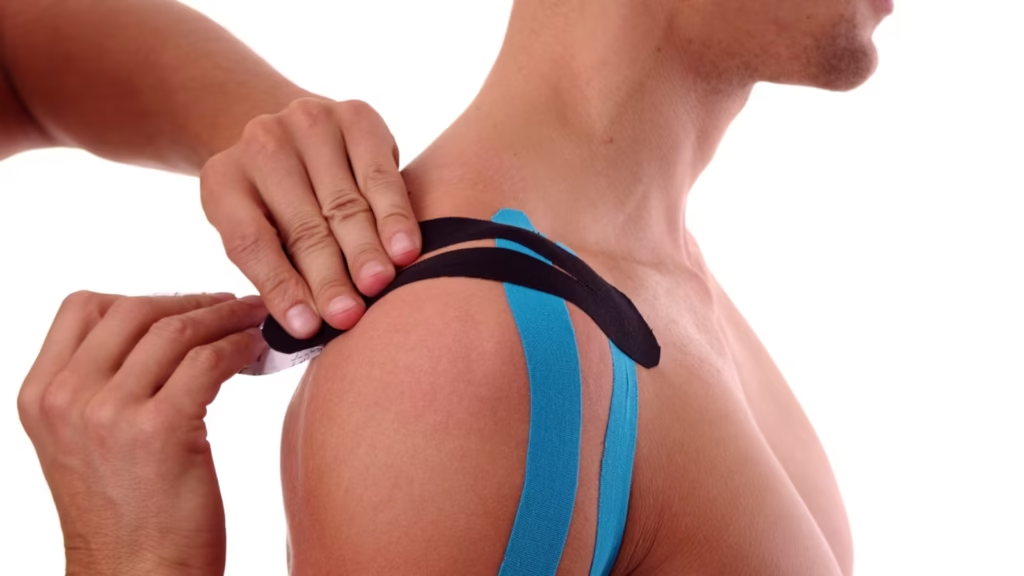Introduction to Kinesiology Taping
Kinesiology taping, first developed in Japan by acupuncturists and chiropractors, is now a globally recognised technique used by sports therapists to treat injuries and manage pain. Unlike traditional athletic tape, which limits movement, kinesiology tape is designed to support the body’s natural mechanics while allowing full flexibility. At Elite Performance Therapy we may integrate kinesiology taping into our sports therapy programmes to promote recovery, alleviate discomfort, and enhance mobility for patients with injuries such as strains, or chronic pain. This non-invasive modality offers a versatile solution for athletes and non-athletes alike, supporting healing and improving function without restricting daily activities.

Mechanics of Kinesiology Taping
Kinesiology tape is crafted to mimic the elasticity of human skin, stretching up to 180% of its original length while retaining exceptional recoil or “snap-back.” This unique stretchiness enables it to move with the body, unlike rigid athletic tapes that constrain motion. Depending on the application—minimal tension for skin lifting or increased stretch for tissue support—the tape interacts with the skin and underlying tissues to produce therapeutic effects. At Elite Performance Therapy, we use precise techniques to tailor kinesiology taping to each patient’s needs, ensuring optimal outcomes for pain relief, swelling reduction, or structural support during recovery.
Core Therapeutic Benefits
Kinesiology taping delivers three primary benefits—fluid, mechanical, and neurological—each enhancing recovery and function:
- Fluid Effect: When applied with minimal tape stretch but significant skin stretch, kinesiology tape creates a bio-mechanical lifting effect, forming slight skin wrinkles. This decompresses underlying tissues, improving fluid dynamics. Swelling diminishes as lymph flows more freely, clearing toxins from inflammation or injury. Enhanced blood circulation delivers oxygen and nutrients essential for healing, often resulting in rapid improvements in bruised or swollen areas, such as post-injury oedema in sprained ankles or knees.
- Mechanical Effect: Decompression restores normal tissue mechanics, allowing layers from skin to muscle to bone to slide and glide smoothly. This can significantly improve mobility, enabling patients with restricted movement—such as those with shoulder or lower back pain—to achieve greater range of motion almost immediately. By facilitating smoother tissue interactions, kinesiology taping reduces discomfort during movement, supporting rehabilitation and daily tasks.
- Neurological Effect: The tape reduces pressure on nerve endings between the skin and muscle, diminishing pain signals at their source. It also stimulates mechanoreceptors in the skin, enhancing proprioception—the body’s awareness of position and movement. Improved proprioception can reduce pain and optimise movement patterns, benefiting patients recovering from joint sprains or dealing with chronic pain conditions requiring better movement control.
When applied with greater stretch, kinesiology tape supports strained, torn, or weakened tissues, providing elastic recoil similar to healthy muscles or ligaments. This stabilises affected areas, reduces tissue fatigue, and aids recovery from injuries like tendonitis, muscle strains, or ligament sprains, enhancing functional stability during activity.
Clinical Applications
At Elite Performance Therapy, kinesiology taping is a cornerstone of our sports therapy approach, customised to address diverse patient needs. Key applications include:
- Pain Management: Taping areas like the lower back, shoulders, or knees to alleviate discomfort from chronic pain or acute injuries, ensuring gentle application for maximum comfort.
- Injury Rehabilitation: Supporting sprained joints (e.g., wrists or ankles) or strained muscles (e.g., quadriceps or rotator cuff) to promote healing and prevent re-injury, ideal for athletes returning to sport.
- Postural Support: Stabilising the spine or shoulders to improve alignment, reducing strain during repetitive tasks or prolonged sitting, beneficial for office workers or manual labourers.
- Swelling Reduction: Applying tape to bruised or swollen areas, such as post-surgical swelling or sports injuries, to enhance lymphatic drainage and accelerate recovery.
- Performance Enhancement: Supporting muscles and joints during athletic activities to improve stability and reduce fatigue, aiding performance in sports like running or tennis.
For acute injuries, taping focuses on decompression to reduce swelling and pain, while chronic conditions benefit from supportive applications to enhance stability.

Practical Considerations and Results
Here at Elite Performance Therapy, we assess each patient’s injury or pain profile to select the appropriate taping technique—decompression for swelling and pain relief or support for stability. The tape, water-resistant and durable, is typically worn for 3–5 days, delivering continuous therapeutic effects during activities like showering, working, or light exercise. Patients frequently report immediate pain relief, improved mobility, and reduced swelling, with cumulative benefits when taping is integrated into a comprehensive sports therapy plan.
Kinesiology taping is safe for most patients, though those with sensitive skin require monitoring to prevent irritation. We would adjust applications based on feedback, ensuring comfort and efficacy. While not a cure, kinesiology taping may enhance recovery by reducing pain, supporting movement, and promoting tissue healing, making it a valuable tool for acute injuries, chronic pain, and performance support. Regular reassessments ensure taping evolves with the patient’s progress, maintaining alignment with therapeutic objectives.
Sustaining Therapeutic Benefits
To maximise kinesiology taping’s benefits, patients are encouraged to:
- Stay Active: Engage in appropriate activities, such as walking r light stretching, to support circulation and mobility in taped areas.
- Maintain Posture: Use taping as a cue to reinforce proper alignment during daily tasks, reducing strain on joints and muscles.
- Adhere to Guidance: Follow therapist recommendations for taping duration and complementary therapies to optimise recovery.
- Monitor Skin Comfort: Report any irritation to ensure taping remains suitable, particularly for prolonged use.
